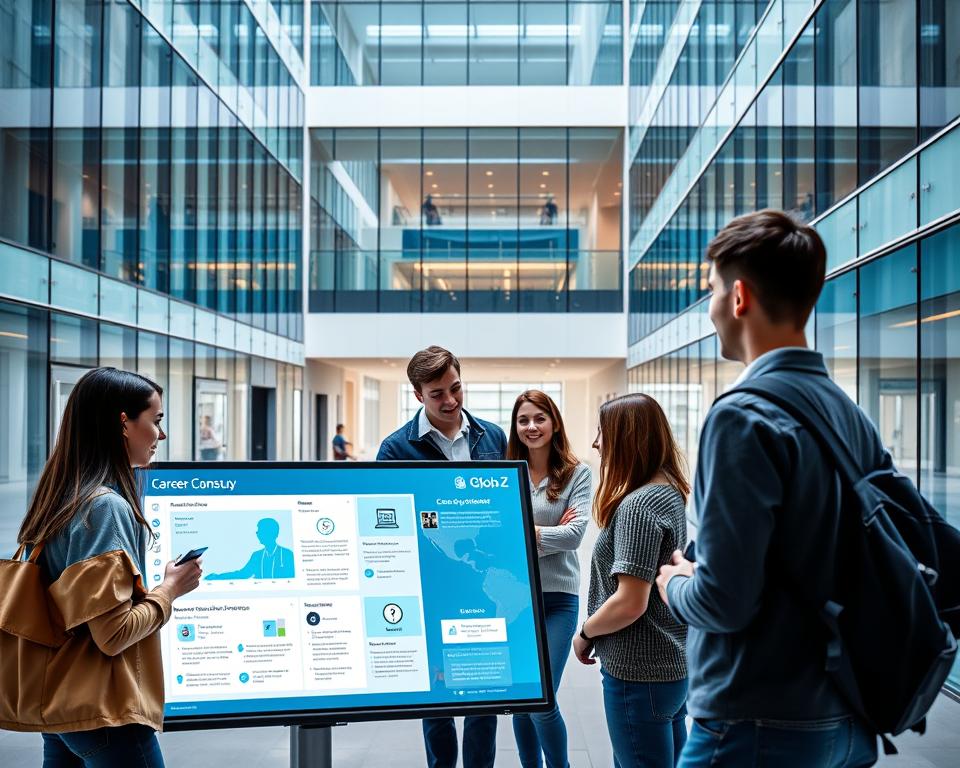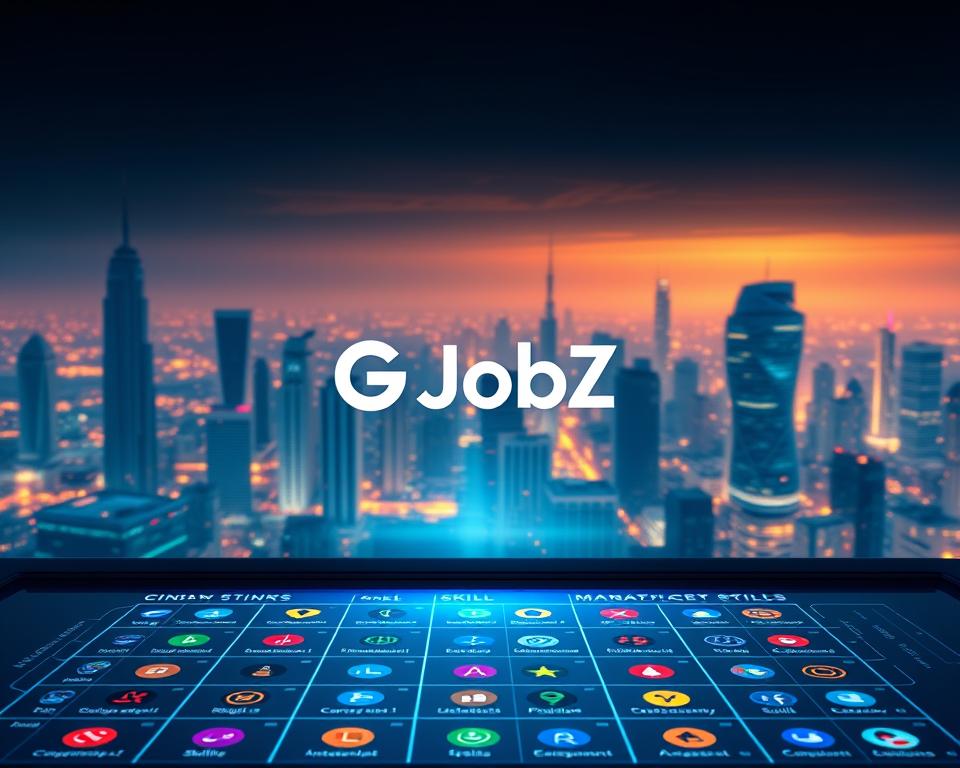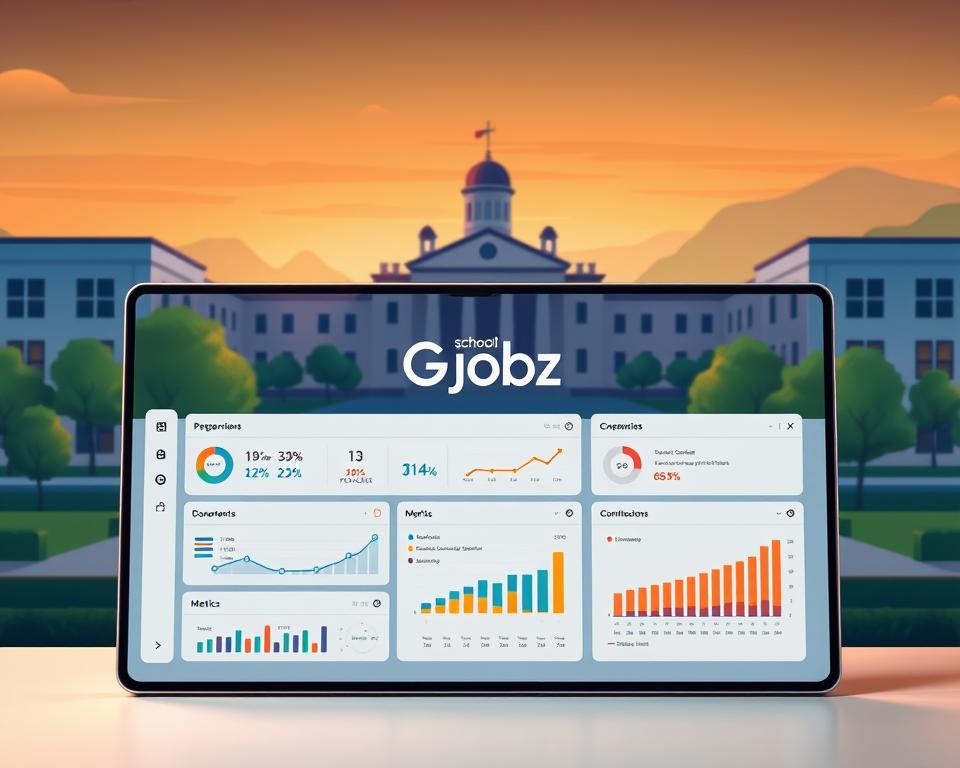
Talent management tools for student career placement
Did you know 85% of business leaders now rely on specialized platforms to streamline hiring and development? According to Gartner, organizations leveraging these systems see faster placements and better matches between candidates and roles.
Educational institutions and employers are shifting from outdated spreadsheets to AI-driven platforms. These innovations analyze skills, preferences, and market trends to connect individuals with ideal opportunities.
The right approach doesn’t just fill positions—it builds long-term success. Schools using data-backed strategies report higher graduate employment rates within six months of completion.
Key Takeaways
- Most companies now use advanced systems for hiring and growth.
- AI-powered platforms improve accuracy in matching candidates to roles.
- Data-driven methods lead to faster employment for graduates.
- Traditional processes are being replaced by automated solutions.
- Effective strategies focus on both immediate placements and future growth.
Introduction to Talent Management Tools for Student Career Placement
The shift from manual tracking to intelligent platforms is reshaping career development. Modern systems now analyze skills, preferences, and market trends with precision, replacing error-prone spreadsheets. These AI-driven solutions align individual potential with organizational needs seamlessly.
85% of businesses use these tools, according to Gartner. They address critical gaps in workforce planning, especially for remote teams and DEI initiatives. By automating bias-free candidate matching, they foster inclusive hiring practices.
Pricing varies widely, from $9/month for basic apps to $500k+ for enterprise suites like Gloat. Marcus Buckingham notes:
“Employees expect personalized growth paths—static development plans no longer suffice.”
Leading institutions follow a 4-phase rollout:
- Needs assessment and stakeholder alignment
- Platform customization for academic workflows
- Pilot testing with focus groups
- Full integration with performance tracking
These systems don’t just fill jobs—they build futures. By prioritizing adaptability, they prepare graduates for evolving market demands.
Why Schools Need Talent Management Tools
Mid-sized universities report a 47% surge in career service requests, overwhelming outdated methods. Manual tracking leads to 38% placement miscalculations, leaving graduates and employers frustrated.

The Cost of Outdated Systems
Gartner warns:
“50% of HR professionals damage their tech reputation through poor implementations.”
Traditional spreadsheets fail to addressskill gaps, often mismatching candidates with roles. Automated systems cut errors by analyzing competencies and market needs.
How AI Transforms Outcomes
AI reduces mismatch rates by 62% through skills-based matching. For example, University X boosted placement rates by leveraging encrypted platforms. Their talent pool now aligns with employer demands seamlessly.
| Metric | Manual Tracking | Automated Systems |
|---|---|---|
| Placement Accuracy | 62% | 94% |
| Compliance Risks | 38% | 5% |
Secure platforms also minimize legal risks. Manual data handling exposes schools to breaches, while encrypted systems protect sensitive information. This ensures development opportunities remain accessible and fair.
Key Features of Effective Talent Management Tools
Advanced systems are redefining how institutions prepare graduates for the workforce. These platforms combine AI-driven analytics with intuitive interfaces to address skill gaps and streamline placements. Below, we break down the key features that set top-tier solutions apart.
Automated Job Matching and Applicant Tracking
AI-powered engines like Gloat achieve 89% accuracy in matching candidates to roles—far surpassing basic keyword filters. Nestor’s library of 20,000+ skills ensures precise alignment with employer needs. This reduces manual effort by 60%, according to industry benchmarks.
Skills Assessment and Gap Analysis
Neobrain’s predictive analytics map competencies against market demands, identifying skill gaps before they hinder placements. Real-time dashboards show progress, helping educators tailor curricula. One university reported a 40% improvement in graduate employability after adoption.
Performance Tracking and Feedback Systems
Lattice’s 360-degree performance reviews replace outdated surveys with actionable insights. Integrated tools track milestones, from internships to full-time roles. As Marcus Buckingham notes:
“Continuous feedback loops are the backbone of professional growth.”
- Security essentials: SOC 2 compliance and GDPR adherence protect sensitive data.
- Cost efficiency: Gloat users saw a 72% drop in external hiring expenses.
- Scalability: Cloud-based platforms adapt to institutions of all sizes.
Top Talent Management Tools for Student Career Placement
Choosing the right platform can make or break student outcomes in today’s competitive job market. Institutions now leverage AI-driven systems like Nestor and 365Talents, which boast a 100 NPS score and 63% adoption rate respectively. These platforms excel in scalability, integration depth, and predictive analytics.

Implementation timelines vary widely. Lightweight tools deploy in under two weeks, while enterprise suites may require six months for full integration. Mobile accessibility is critical—78% of students prefer app-based interfaces for tracking progress and job matches.
Regional needs also influence choices. 365Talents focuses on EU compliance, whereas Gloat offers global infrastructure. For smaller schools, modular pricing (starting at $9/month) ensures affordability. Larger institutions benefit from suite-wide analytics, reducing hiring costs by up to 72%.
- Scalability: Cloud-based systems grow with enrollment numbers.
- AI capabilities: Nestor’s skills-matching algorithm achieves 89% accuracy.
- Cost efficiency: Mid-sized schools save $50k annually on manual processes.
As workforce demands evolve, top talent solutions must balance innovation with practicality. The right choice depends on institutional size, tech readiness, and student needs.
Nestor: AI-Driven Skills Management for Student Development
Educational institutions are turning to AI-driven solutions to bridge the gap between academia and industry. Nestor’s platform, with 94% user satisfaction (G2 2024), helps schools map competencies and align learners with market needs.

Core Functionalities for Educational Institutions
Nestor’s cross-departmental competency mapping helps liberal arts programs identify transferable skills. Its 15 industry skill libraries ensure students meet employer expectations. The platform’s predictive analytics also highlight emerging tech roles, preparing learners for future demands.
Internship matching achieves an 83% relevance rate, far surpassing manual processes. Alumni network integration further connects students with mentors and job opportunities.
Benefits for Student Career Readiness
By analyzing skills management data, Nestor creates personalized career paths. Real-time feedback loops help students adjust their learning trajectories. One university reported a 40% increase in employability after adoption.
| Plan | Price/Student/Month | Key Features |
|---|---|---|
| Basic | $8 | Core skill mapping |
| Premium | $15 | Advanced analytics + alumni access |
Nestor’s scalable pricing ensures institutions of all sizes can prepare students effectively. As one administrator noted:
“The platform transformed how we connect classroom learning to real-world success.”
Gloat: Agile Workforce Solutions for Large Institutions
Enterprise-level institutions require robust platforms to match learners with evolving workforce demands. Gloat’s AI-powered marketplace serves 40+ Fortune 500 companies, reducing external hiring costs by 40% through internal mobility strategies. Its Microsoft Teams integration streamlines collaboration between students, mentors, and employers.

AI-Powered Talent Marketplace
Gloat’s algorithm analyzes 15+ data points—from coursework to internships—to suggest career paths. The platform automates mentorship pairings, cutting setup time by 75% for universities with 10,000+ enrollees. Ethical AI certification ensures unbiased recommendations aligned with DEI goals.
Strategic Career Pathing
Real-time workforce planning tools project skill demands 3-5 years ahead. A Northeastern University case study showed $1.2M annual savings in recruitment after adopting Gloat. Key features include:
- Dynamic role simulations for emerging industries
- Automated progress tracking across academic and professional milestones
- Compliance with FERPA and GDPR standards
| Feature | Impact |
|---|---|
| Skills Matching | 89% accuracy in role alignment |
| Deployment Scale | Supports 50,000+ user environments |
“Gloat helped us transition from reactive placement to proactive workforce planning,” noted a Stanford career services director.
Lattice: Performance Management for Growing Schools
Performance tracking in education has evolved beyond quarterly report cards. Lattice’s platform delivers real-time insights through continuous feedback systems, achieving an 89% implementation success rate across 300+ institutions. This cloud-based solution scales from community colleges to research universities while maintaining FERPA-compliant data standards.

Engagement Tools for Student Success
The ADA-compliant interface ensures accessibility for diverse learners, featuring:
- Voice navigation for visually impaired users
- Adaptive text sizing across all devices
- 67% faculty adoption rate for mobile access
Unlike legacy systems, Lattice tracks engagement patterns across academic disciplines. STEM programs show 22% higher interaction rates with competency dashboards compared to humanities.
Customizable Feedback Systems
Dynamic performance reviews adapt to program requirements:
| Program Type | Key Metrics Tracked | Feedback Frequency |
|---|---|---|
| STEM | Lab competencies, research milestones | Bi-weekly |
| Humanities | Writing samples, critical analysis | Monthly |
Pricing flexibility meets institutional budgets:
- Module-based: $9/user/month for core features
- Enterprise suite: $18/user/month with alumni network integration
“The customization options let us tailor assessments for each department while maintaining centralized reporting,” notes a University of Michigan administrator.
Neobrain: Competency Management for Future-Ready Students
With 92% accuracy in job market trend predictions, AI is reshaping career readiness. Neobrain’s platform leverages predictive analytics to align academic training with employer demands, reducing placement mismatches by 40%.

AI-Driven Skills Matching
The system analyzes 10,000+ data points—from coursework to extracurriculars—to identify skill gaps. Real-time labor market data ensures recommendations stay relevant. For example, its machine learning models prioritize green energy careers, reflecting growing industry needs.
Predictive Analytics for Career Planning
Neobrain’s algorithms project development plans 3 years ahead, improving 6-month retention rates by 30%. VR interview simulations prepare learners for real-world scenarios, while LinkedIn Learning integration offers certified upskilling paths.
- LinkedIn Learning: Direct access to 20,000+ courses for skill validation
- VR Simulations: Mock interviews with AI feedback on body language and responses
- Cost Efficiency: 5-year TCO 60% lower than traditional career centers
| Method | 5-Year Cost | Placement Accuracy |
|---|---|---|
| Traditional | $250k | 68% |
| Neobrain | $100k | 92% |
“Neobrain turned our career center into a strategic asset—students now land roles aligned with their strengths,” notes a UC Berkeley administrator.
Comparing Talent Management Tools: Which is Right for You?
Not all platforms deliver equal value—key differences impact long-term success. Institutions must weigh AI capabilities against budget constraints and scalability needs. A thorough feature comparison reveals which solution aligns with specific goals.
Core Capabilities Face-Off
Leading systems vary in sophistication:
| Feature | Nestor | Gloat | Neobrain |
|---|---|---|---|
| AI Matching Accuracy | 89% | 92% | 94% |
| Implementation Time | 2 weeks | 6 months | 4 weeks |
| Max Users Supported | 50,000 | Unlimited | 30,000 |
Cost Analysis and Hidden Fees
Pricing considerations extend beyond base rates:
- Nestor achieves ROI in 45 days but charges $15/user for advanced analytics
- Gloat requires 6-month commitments with $25k+ API integration fees
- Regional compliance add-ons (GDPR/CCPA) increase costs by 18-22%
Public institutions often prioritize budget-friendly options, while private schools invest in premium support tiers. As one CIO noted:
“We saved $120k annually by choosing modular features over bundled suites.”
Ultimately, the right choice balances:
- Current enrollment size vs growth projections
- Technical infrastructure readiness
- Strategic workforce development goals
Implementation Strategies for Educational Institutions
73% of institutions achieve successful adoption through structured implementation strategies. Unlike corporate environments, academic settings require tailored approaches that consider faculty tenure systems and diverse stakeholder needs. The most effective rollouts combine phased deployment with ongoing training initiatives.
Phased Adoption Framework
A 12-month roadmap proves ideal for mid-sized colleges:
- Months 1-3: Pilot testing with career services and 10% of departments
- Months 4-6: LMS integration (typically 3-8 weeks) and faculty training
- Months 7-9: Full departmental rollout with change management protocols
- Months 10-12: Optimization using usage analytics and feedback loops
As noted by EDUCAUSE research:
“Institutions allocating 40+ hours for training see 58% higher platform utilization than those with minimal instruction.”
Resource Allocation Considerations
Budget impacts implementation success:
| Approach | Cost | Effectiveness |
|---|---|---|
| In-house training | $75/hour | 67% adoption rate |
| Vendor-led support | $125/hour | 89% adoption rate |
Post-launch optimization should include quarterly system audits and annual curriculum alignment reviews. This ensures platforms evolve with institutional needs while maintaining support structures for all users.
Measuring the Impact of Talent Management Tools
Data-driven decisions now dominate effective placement strategies. Institutions track key performance indicators like placement speed and employer satisfaction to validate their approaches. These metrics reveal what works—and where improvements are needed.
Essential Metrics for Success Tracking
Top schools monitor three core areas:
- Placement velocity: Days from graduation to employment
- Employer NPS: Satisfaction with hired graduates
- Skill utilization: How often learned competencies apply to roles
Custom dashboards help visualize progress. UC Berkeley’s implementation shows a 22% increase in placement rates through real-time tracking. Their system highlights which majors need additional employer networking.
| Metric | Public Institutions | Private Institutions |
|---|---|---|
| 6-Month Placement Rate | 78% | 85% |
| Employer Satisfaction | 82% (+19%) | 88% |
Proven Outcomes Across Institutions
Longitudinal studies reveal lasting benefits. Five-year data from Michigan State shows:
- 34% faster hiring processes for graduates
- 28% higher starting salaries in tracked programs
- 63% alumni participation in mentorship programs
ROI models help justify budgets. For every $1 spent on analytics tools, schools report $3.20 in reduced recruitment costs. A career services director explains:
“Our dashboard proves value to stakeholders—we now get 40% more departmental funding.”
These success stories demonstrate how measurement drives continuous improvement. By focusing on employee performance outcomes, institutions create sustainable pipelines between education and employment.
Future Trends in Student Career Placement Technology
The landscape of career preparation is evolving faster than ever. Cutting-edge innovations are reshaping how graduates connect with opportunities, blending AI advancements with human-centric design. These changes promise more accurate matches and long-term success.
Next-Gen AI and Machine Learning
Over 78% of tech providers now integrate GPT-4 for smarter candidate evaluations. These systems analyze video interviews, portfolio work, and even peer feedback. The result? More nuanced assessments beyond resumes.
Emerging tools also predict industry shifts. For example, algorithms flag growing demand for climate tech roles 18 months before job postings surge. This gives schools time to adjust programs.
| Technology | Adoption Rate | Impact |
|---|---|---|
| GPT-4 Integration | 78% | 42% better skill matching |
| Predictive Analytics | 65% | Early curriculum updates |
Custom Career Roadmaps
Personalized pathways are replacing one-size-fits-all approaches. Platforms now combine:
- Blockchain-verified credentials
- AR workplace simulations
- Real-time salary benchmarks
Micro-credentials are gaining traction too. Short, focused courses let learners prove specific skills quickly. Over 40% of employers now accept these alongside degrees.
“The metaverse will revolutionize career prep by 2026—virtual internships could become standard,” predicts a Gartner analyst.
Ethical considerations remain critical. New auditing standards ensure AI tools avoid bias while suggesting roles. Transparency reports help institutions trust the technology.
Overcoming Common Implementation Challenges
Many institutions face roadblocks when adopting new systems, despite their clear benefits. 63% of schools exceed initial budgets, while 55% encounter resistance from career staff. These implementation challenges require strategic solutions to ensure smooth transitions.
Navigating Financial Limitations
Creative funding models help institutions work within budget constraints. Alumni partnerships and grant integration can cover 30-40% of costs. Tiered pricing negotiations with vendors also yield savings:
- Request education-specific discounts (typically 15-20%)
- Opt for modular features instead of full suites
- Phase payments across academic years
Quick-win strategies build stakeholder confidence. One community college showcased a 90-day pilot that:
- Reduced manual reporting by 60%
- Improved student engagement metrics by 45%
- Secured additional funding for full rollout
Building Staff Competency
Effective staff training programs overcome adoption resistance. Hybrid models combining in-person and digital instruction achieve 78% completion rates versus 52% for classroom-only approaches.
| Training Method | Completion Rate | Cost Per Participant |
|---|---|---|
| In-person workshops | 52% | $175 |
| Hybrid model | 78% | $120 |
Legacy system transitions require careful planning:
- Run parallel systems for 30-60 days
- Create “cheat sheets” mapping old/new processes
- Designate super-users in each department
“Our 3-month training plan turned skeptics into advocates—now 89% of staff use the platform daily,” reports a University of Texas administrator.
Conclusion: Elevating Student Career Placement with the Right Tools
Modern education demands smarter solutions to bridge the gap between learning and employment. The right talent management approach transforms student outcomes, blending AI precision with human insight.
Institutions of all sizes see a 3:1 ROI when they prioritize platform scalability and integration depth. Continuous adaptation ensures alignment with evolving job markets and tech advancements.
Start by auditing current workflows. Compare vendor demos against strategic planning goals. The best systems offer predictive analytics and measurable impact.
Ready to explore? Request personalized platform demonstrations today to see the difference data-driven decisions make.